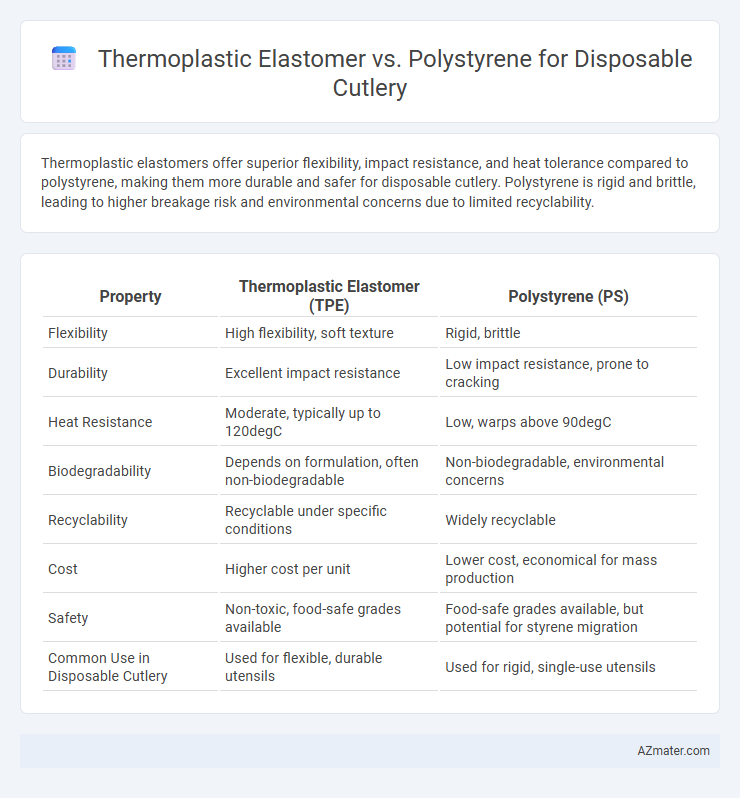Thermoplastic elastomers offer superior flexibility, impact resistance, and heat tolerance compared to polystyrene, making them more durable and safer for disposable cutlery. Polystyrene is rigid and brittle, leading to higher breakage risk and environmental concerns due to limited recyclability.
Table of Comparison
| Property | Thermoplastic Elastomer (TPE) | Polystyrene (PS) |
|---|---|---|
| Flexibility | High flexibility, soft texture | Rigid, brittle |
| Durability | Excellent impact resistance | Low impact resistance, prone to cracking |
| Heat Resistance | Moderate, typically up to 120degC | Low, warps above 90degC |
| Biodegradability | Depends on formulation, often non-biodegradable | Non-biodegradable, environmental concerns |
| Recyclability | Recyclable under specific conditions | Widely recyclable |
| Cost | Higher cost per unit | Lower cost, economical for mass production |
| Safety | Non-toxic, food-safe grades available | Food-safe grades available, but potential for styrene migration |
| Common Use in Disposable Cutlery | Used for flexible, durable utensils | Used for rigid, single-use utensils |
Introduction to Disposable Cutlery Materials
Thermoplastic elastomers (TPE) and polystyrene (PS) are prominent materials used in disposable cutlery manufacturing due to their distinct properties and cost-effectiveness. TPE offers superior flexibility, durability, and resistance to impact, making it suitable for reusable or sturdier disposable utensils. Polystyrene is favored for its rigidity, low cost, and ease of molding, commonly used in mass-produced, single-use cutlery where stiffness is required.
Overview of Thermoplastic Elastomers (TPE)
Thermoplastic elastomers (TPE) offer a flexible, durable, and eco-friendly alternative to polystyrene in disposable cutlery applications due to their rubber-like elasticity and recyclability. TPE materials combine the processing advantages of thermoplastics with the performance characteristics of elastomers, providing enhanced impact resistance and user comfort. Their potential for reduced environmental impact and safe food contact makes TPE increasingly preferred over traditional polystyrene in sustainable disposable tableware.
Understanding Polystyrene in Disposable Utensils
Polystyrene is widely used in disposable cutlery due to its rigidity, lightweight properties, and cost-effectiveness, making it ideal for mass production of single-use utensils. Its brittleness and low impact resistance, however, limit durability compared to thermoplastic elastomers, which offer superior flexibility and resilience. Polystyrene's ease of molding and smooth finish contribute to its popularity despite environmental concerns related to recyclability and biodegradability.
Mechanical Properties: Flexibility and Strength Comparison
Thermoplastic elastomers (TPE) exhibit superior flexibility and impact resistance compared to polystyrene (PS), making them ideal for disposable cutlery that requires bending without breaking. Polystyrene offers higher stiffness and tensile strength but is brittle under stress, leading to frequent cracking or snapping during use. TPE's balanced mechanical properties ensure durable, comfortable cutlery that withstands diverse handling conditions, outperforming PS in applications demanding both strength and flexibility.
Aesthetic Appeal and Design Versatility
Thermoplastic elastomers (TPE) offer superior aesthetic appeal for disposable cutlery due to their ability to mimic the soft, flexible texture of rubber, allowing for smooth, matte finishes and vibrant color options that enhance visual appeal. Polystyrene, in contrast, provides a rigid, glossy surface ideal for sharp, clean lines but limits design versatility because of its brittleness and sensitivity to deformation. The flexibility of TPE enables innovative ergonomic designs and intricate details, making it a preferred choice for customizable, user-friendly disposable cutlery.
Safety and Food Contact Regulation Compliance
Thermoplastic elastomers (TPE) used for disposable cutlery typically comply with FDA and EU food contact regulations due to their chemical stability and resistance to leaching harmful substances. Polystyrene (PS), while common in disposable utensils, raises concerns over potential styrene monomer migration, necessitating strict compliance testing to meet safety standards. Both materials must undergo rigorous certification processes, but TPE is often favored for enhanced flexibility and reduced risk of toxin transfer in food contact applications.
Environmental Impact and Biodegradability
Thermoplastic elastomers (TPE) used in disposable cutlery offer improved flexibility and potential for recyclability, reducing environmental impact compared to traditional polystyrene (PS), which is rigid and difficult to recycle. Polystyrene is notorious for its persistence in landfills and oceans, taking hundreds of years to decompose, contributing significantly to plastic pollution. TPE materials, while not fully biodegradable, can be engineered for enhanced recyclability and lower ecological footprint, making them a more sustainable option over conventional polystyrene in disposable cutlery applications.
Cost-effectiveness and Production Scalability
Thermoplastic elastomers offer superior cost-effectiveness for disposable cutlery due to their lower raw material costs and reduced processing energy requirements compared to polystyrene, facilitating more budget-friendly large-scale production. Production scalability is enhanced with thermoplastic elastomers because of their faster cycle times and greater flexibility in molding complex designs, allowing manufacturers to increase output without significant capital investment. In contrast, polystyrene's brittle nature limits design complexity and requires higher processing temperatures, which can escalate production costs and slow scalability for mass manufacturing.
Consumer Preference and User Experience
Thermoplastic elastomers (TPE) offer superior flexibility and durability compared to polystyrene, resulting in a more comfortable and less brittle user experience for disposable cutlery. Consumers tend to prefer TPE cutlery due to its improved grip and resistance to cracking under pressure or heat, enhancing overall satisfaction during use. In contrast, polystyrene cutlery, while cost-effective, often receives negative feedback related to breakage and discomfort, affecting repeated use and consumer acceptance.
Conclusion: Choosing the Right Material for Disposable Cutlery
Thermoplastic elastomers (TPE) offer superior flexibility, durability, and recyclability compared to polystyrene, making them a more sustainable choice for disposable cutlery. Polystyrene, while cost-effective and rigid, poses environmental concerns due to its non-biodegradability and challenges in recycling. Selecting TPE aligns with eco-friendly practices and consumer demand for durable yet disposable utensils.

Infographic: Thermoplastic elastomer vs Polystyrene for Disposable cutlery
 azmater.com
azmater.com